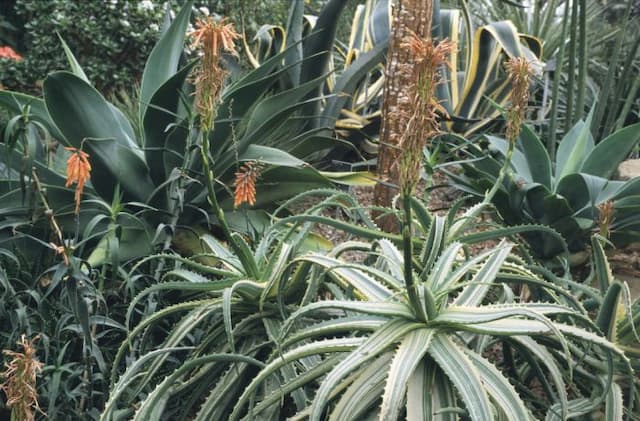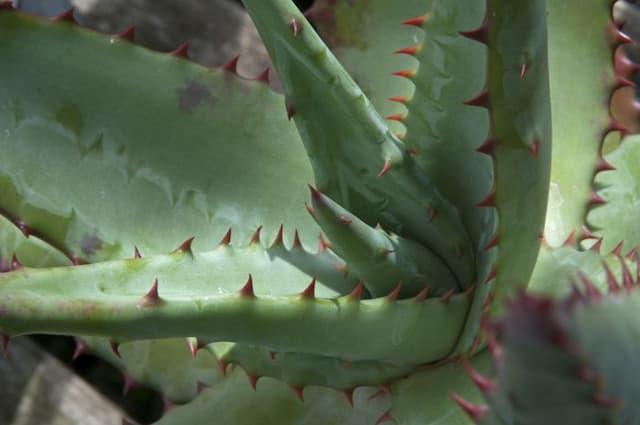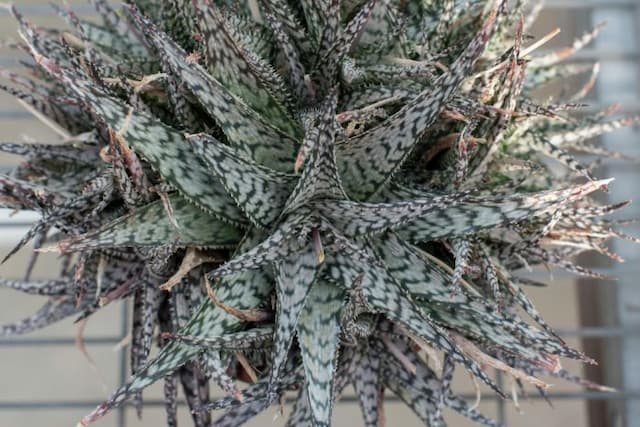Baker's Aloe Aloe bakeri

ABOUT
Baker's aloe, commonly known as Aloe bakeri, is a succulent plant recognized for its distinctive and decorative appearance. This aloe typically forms a rosette shape, which is a circular arrangement of leaves. The leaves are fleshy and thick, facilitating water storage for the plant's survival in arid environments. The foliage usually bears a green to grey-green color and may exhibit various shades depending on the specific conditions it is grown in. The surface of the leaves can appear to have a bumpy texture because of small white bumps or spots, which are often distributed across the leaf surface. These spots add to the plant's ornamental value, giving it a speckled appearance that can be quite striking. The edges of the leaves are often lined with small teeth-like projections, which can be sharp. These serrations are typical of many aloe species and give the foliage an edgy contour, contributing to its aesthetic appeal. During the appropriate season, Baker's aloe may produce flowers. The blooms tend to rise from the center of the rosette on a tall stalk, and the flowers are typically tubular in shape. They often come in vibrant shades of red, orange, or yellow, injecting a pop of color above the more subdued tones of the foliage. Overall, the visual appeal of Baker's aloe lies in its rosette form, the texture of its spotted leaves, the serrated leaf edges, and its seasonal, brightly colored flowers. The plant's structure and features make it a popular choice for those looking to add an exotic and drought-tolerant element to their garden or indoor plant collection.
About this plant
 Names
NamesFamily
Asphodelaceae
Synonyms
Baker's Aloe
Common names
Aloe bakeri
 Toxicity
ToxicityTo humans
The plant commonly known as Aloe bakeri has not been specifically documented for its toxicity to humans. However, many aloe plants contain aloin, a compound that can cause gastrointestinal distress if ingested. If Aloe bakeri is similar to other aloe species in this respect, consuming parts of the plant might lead to symptoms such as diarrhea, cramps, nausea, and in severe cases, electrolyte imbalance. Handling the plant does not typically result in toxicity unless the latex from the leaves is ingested.
To pets
Aloe bakeri, commonly known as a type of aloe, is toxic to pets including cats and dogs. If a pet ingests part of an aloe plant, they may experience symptoms such as vomiting, diarrhea, lethargy, changes in urine color, or tremors. These symptoms result from the plant's saponins and anthraquinones. Ingestion can lead to gastrointestinal upset and may require veterinary attention to manage the symptoms and ensure the pet's safety and well-being.
 Characteristics
CharacteristicsLife cycle
Perennials
Foliage type
Evergreen
Color of leaves
Green
Flower color
Orange
Height
1 feet (0.3 meters)
Spread
1 feet (0.3 meters)
Plant type
Succulent
Hardiness zones
10
Native area
Madagascar
Benefits
 General Benefits
General Benefits- Easy to care for: Aloe bakeri does not require frequent watering or complex maintenance, making it ideal for busy plant owners or beginners.
- Drought-tolerant: This plant can survive periods of dryness due to its succulent nature, storing water in its leaves.
- Aesthetic appeal: With its green, fleshy leaves and compact size, Aloe bakeri adds a touch of natural beauty to any indoor space.
- Non-toxic to pets: Aloe bakeri is generally safe around pets, reducing concerns about accidental ingestion by cats or dogs.
 Medical Properties
Medical Properties- This plant is not used for medical purposes.
 Air-purifying Qualities
Air-purifying QualitiesThis plant is not specifically known for air purifying qualities.
 Other Uses
Other Uses- Aloe bakeri can be used as a decorative element in fairy gardens or miniature landscapes due to its small size and attractive foliage.
- It's suitable for creating living jewelry, such as necklaces or bracelets, when the small offsets are placed in tiny pots or attached to wearable platforms.
- The gel from the Aloe bakeri can potentially be used as a natural hair styling gel or to tame eyebrows, given its sticky consistency.
- This plant can be utilized in educational settings, such as schools, to teach children about plant biology and propagation techniques.
- Aloe bakeri may be used as a natural dye for fabrics or paper, although it is not commonly known for this use.
- The leaves can be used in arts and crafts to create plant imprints on clay or homemade paper for a unique texture or pattern.
- It can be used as an indicator plant in a greenhouse or home, showing the need for watering when the leaves begin to wrinkle.
- This plant may be used in culinary presentations as an edible garnish, although it is not traditionally eaten.
- Aloe bakeri can be used in photography as a subject for macro photography due to its intricate details and succulent leaves.
- The thick leaves may be used as a natural barrier or boundary in potted plant arrangements, providing structure and contrast.
Interesting Facts
 Feng Shui
Feng ShuiThe Aloe Vera is not used in Feng Shui practice.
 Zodiac Sign Compitability
Zodiac Sign CompitabilityThe Aloe Vera is not used in astrology practice.
 Plant Symbolism
Plant Symbolism- Healing and protection: Similar to its aloe vera relative, Aloe bakeri is often associated with healing due to its medicinal properties, suggesting the plant symbolizes healing and protection from ailments.
- Persistence and Resilience: Given its succulent nature, the plant can survive in tough conditions which makes it a symbol of persistence and resilience in the face of challenges.
- Beauty in solitude: Aloe bakeri can thrive in isolation and still produce beautiful flowers, symbolizing the ability to find beauty in solitude or independence.
 Water
WaterThe Aloe bakeri, commonly known as Baker's Aloe, should be watered sparingly, as it is prone to root rot if overwatered. Allow the soil to dry out completely before adding water again, which typically means watering every two to three weeks, depending on the humidity and temperature conditions. When watering, do so thoroughly, ensuring water reaches the roots, but avoid letting the plant sit in water. An estimated amount would be about 8-12 ounces at a time for a medium-sized pot, adjusted according to pot size and environmental conditions.
 Light
LightBaker's Aloe thrives best in bright, indirect sunlight. It's ideally placed in an east or west-facing window where it can receive plenty of light without the harshness of direct midday sun. If you only have south-facing windows, ensure a sheer curtain or similar barrier is used to diffuse the intense light, preventing leaf scorch.
 Temperature
TemperatureThe optimal temperature range for Baker's Aloe is between 60 and 75 degrees Fahrenheit. It can tolerate a minimum temperature of 50 degrees Fahrenheit and a maximum of 80 degrees Fahrenheit, but prolonged exposure to temperatures outside of these limits can be harmful. The plant prefers a stable temperature and should be protected from drafts and sudden temperature changes.
 Pruning
PruningPruning Baker's Aloe is mainly for removing dead or damaged leaves to maintain its appearance and health. It doesn't require frequent pruning, but inspecting the plant every few months and snipping away any unsightly leaves is beneficial. The best time for pruning is in the spring or early summer when the plant is entering its active growth phase.
 Cleaning
CleaningAs needed
 Soil
SoilAloe bakeri, commonly known as Baker's Aloe, thrives in well-draining sandy or gritty soil mix. A cactus potting mix combined with perlite or pumice enhances drainage. The ideal pH range for Baker's Aloe soil should be slightly acidic to neutral, around 6.0 to 7.5.
 Repotting
RepottingBaker's Aloe should be repotted approximately every 2-3 years, or when it outgrows its container. The best time to repot is during the warm growth season.
 Humidity & Misting
Humidity & MistingBaker's Aloe prefers dry air and does not require high humidity levels, making it suitable for typical indoor environments. Aim to maintain average indoor humidity levels between 30-50%.
 Suitable locations
Suitable locationsIndoor
Place Baker's Aloe near a sunny window; water sparingly.
Outdoor
Plant in sunny spot, protect from cold, water moderately.
Hardiness zone
9-11 USDA
 Life cycle
Life cycleAloe bakeri, commonly known as Baker's Aloe, commences its life cycle as a seed, germinating in warm, well-draining soil conditions with minimal moisture. Upon germination, a small rosette of succulent leaves forms, characterizing the seedling stage. As the plant matures, it enters a vegetative state where it grows larger, develops a stronger root system, and the leaves become more pronounced and may show characteristic colorations or markings. Flowering occurs once the plant is mature enough, producing tubular, typically orange-red flowers on tall spikes, attracting pollinators such as bees and hummingbirds. Following pollination, seeds are developed within capsules that, upon drying, open to release seeds and complete the reproductive cycle. Aloe bakeri may also reproduce vegetatively through offsets or "pups" that sprout from the base of the parent plant, leading to new genetically identical individuals.
 Propogation
PropogationPropogation time
Spring to Summer
Aloe bakeri, commonly known as Baker's aloe, is typically propagated through the division of offsets, also known as pups. The best time to propagate Baker's aloe is during the warmer months of spring or summer when the plant is actively growing. To propagate by division, gently remove the offsets that form around the base of the parent plant. These pups usually have their own roots and can be easily separated. Once removed, allow the offsets to dry for 1-2 days to form a callus on the cut surface, which helps prevent rotting. Then plant the pups in well-draining soil, water lightly, and wait for them to establish a new root system, after which care can be resumed as for the adult plants.









